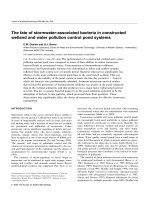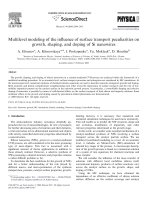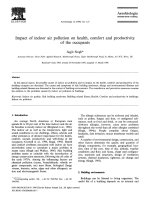- Trang chủ >>
- Khoa Học Tự Nhiên >>
- Vật lý
the politics of child sexual abuse emotion social movements and the state aug 2009
Bạn đang xem bản rút gọn của tài liệu. Xem và tải ngay bản đầy đủ của tài liệu tại đây (1011.27 KB, 273 trang )
The Politics of Child Sexual Abuse
This page intentionally left blank
THE POLITICS OF CHILD SEXUAL ABUSE
Emotion, Social Movements, and the State
Nancy Whittier
1
2009
3
Oxford University Press,Inc., publishes works that further
Oxford University’s objective of excellence
in research,scholarship, and education.
Oxford New York
Auckland Cape Town Dar es Salaam Hong Kong Karachi
Kuala Lumpur Madrid Melbourne Mexico City Nairobi
New Delhi Shanghai Taipei Toronto
With offices in
Argentina Austria Brazil Chile Czech Republic France Greece
Guatemala Hungary Italy Japan Poland Portugal Singapore
South Korea Switzerland Thailand Turkey Ukraine Vietnam
Copyright # 2009 by Oxford University Press
Published by Oxford University Press, Inc.
198 Madison Avenue, New York, New York 10016
www.oup.com
Oxford is a registered trademark of Oxford UniversityPress
All rights reserved. No part of this publication may be reproduced,
stored in a retrieval system, or transmitted, in any form or by any means,
electronic, mechanical, photocopying, recording, or otherwise,
without the prior permission of Oxford University Press.
Library of Congress Cataloging-in-Publication Data
Whittier, Nancy, 1966
The politics of child sexual abuse : emotions, social movements, and
the state / Nancy Whittier.
p. cm.
Includes bibliographical references and index.
ISBN 978-0-19-532510-2
1. Child sexual abuse. 2. Child sexual abuse Government policy.
I. Title.
HV6570.W55 2009
362.76 dc22 2008053887
987654321
Printed in the United States of America
on acid-free paper
For Sally A. Kennedy
This page intentionally left blank
Acknowledgments
I am grateful for the communities of scholars, students, and activists who
have provided feedback and a sounding board as I have worked on this
research. My students at Smith College have been a source of inspiration;
their questions and comments have enriched my thinking about gender,
sexuality, social movements, and politics. My friends and colleagues
at Smith and elsewhere have shaped my analysis through countless conver-
sations about this project and the conceptual and political issues it raises.
The activists whom I interviewed for this book gave generously of their
time and insight and shared their recollections and impressions freely.
Their courage and persistence are inspiring, and I am grateful that writing
this book allowed me to get to know them.
I have been fortunate to have many excellent student research assistants
at Smith. Allyson Mount did the initial literature sources, searched the
archives for early feminist documents, transcribed interviews, and provided
many useful comments and suggestions. Carolyn Gillis transcribed many
interviews; Meg Chilton collected data on federal legislation; Laura Braun-
stein assisted with coding organizational documents; and Meg Nicoll located
information on federal grants. Morgan Lynn collected and sorted a daunting
amount of data on state and federal legislation, and was a fantastic sounding
board; she also read and commented on parts of the manuscript. Adrienne
Mathews intrepidly sought answers to my diverse queries on everything
from public policy to media coverage to movement history. Smith’s Commit-
tee on Faculty Compensation and Development provided the funding for
these assistants. Also at Smith, reference librarian Sika Berger was a helpful
resource for my research assistants and for me, as were the reference staff
in the Sophia Smith Collection. The student activists in Smith’s SAFE
(Survivors and Friends for Education) and AWARE (Activist Women Advo-
cating Rape Education) were an inspiration.
Martha Ackelsberg, Francesca Cancian, Rick Fantasia, Sally Kennedy,
Morgan Lynn, Robin Maltz, Greg Maney, Jo Reger, Kim Voss, Kate Weigand,
and participants in the Smith College Kahn Institute for Liberal Arts project
on “From Local to Global: Community Activism in the New Millennium”
commented on parts of the manuscript or related papers. Donna Jenson
helped me talk through several thorny issues. Elaine Westerlund, Kathy
Morrissey, and Maggie Jochild generously provided access to their personal
archives. Tricia Bruce provided useful information about clergy abuse.
The cover image is from a quilt made by Michelle Harris, Frances Grossman,
K.L., Kathy Morrissey, and Elaine Westerlund. I am grateful to them for
allowing me to reproduce it. Several hardy souls read and commented on
the whole thing in its much-longer original form: Leila Rupp, Ross Cheit,
Janice Irvine, Debra Minkoff, and several anonymous reviewers for OUP.
James Cook, my editor at OUP, had many useful comments and suggestions.
I am grateful for these comments, and the book is better as a result. Writing
about child sexual abuse can be difficult and depressing, and I am especially
grateful to Jo Reger for her support throughout the research and writing.
This project has been with me through the birth and early childhood of
three children, my own health problems and those of family members, one
major move, two terms as Chair of my department, three computers, numer-
ous smaller writing projects, and many other disruptions major and minor. It
might have been done more quickly without all of these, but it would
probably not have been done as well, and I certainly would have enjoyed
the doing less. I particularly appreciate my partner, Kate Weigand, my oldest
son, Jonah, who was two when I began the research, and my twins, Eva and
Isaac, who were born in the midst of it. Thank you for the distraction and the
support.
This book is dedicated to my late mother, Sally A. Kennedy. While she
did not live to see it published, her influence is on every page, in my attempt
to write precisely and to understand the complexities of human interaction.
viii Acknowledgments
Contents
Acronyms xi
Introduction 3
1 From Rare Perversion to Patriarchal Crime: Feminist
Challenges to Knowledge about Incest in the 1970s 21
2 The Politics of the “Therapeutic Turn”: Self-Help and
Internalized Oppression 40
3 Social Services, Social Control, and Social Change:
The State and Public Policy in the 1970s and 1980s 70
4 Going Mainstream: Self-Help Activism During the 1980s 95
5 Diffusion and Dilution: Mass Culture Discovers Child
Sexual Abuse 111
6 Turning Tides: Countermovement Organizing,
“False Memory Syndrome,” and the Struggle over
Scientific Knowledge 133
7 The Politics of Visibility: Coming Out, Activist Art,
and Emotional Change 167
8 The Paradoxical Consequences of Success 182
Conclusion 208
Notes 215
References 237
Index 253
x Contents
Acronyms
APSAC (American Professional Society on the Abuse of Children)
CAP (Child Assault Prevention Project)
CAPTA/CAPTARA (Child Abuse Prevention and Treatment Act/
Child Abuse Prevention and Treatment and Adoption Reform Act)
CMHC (Community Mental Health Centers)
CPS (Child Protective Services)
FMSF (False Memory Syndrome Foundation)
HEW (United States Department of Health, Education, and Welfare)
IAF (Incest Awareness Foundation)
IR (Incest Resources)
ISA (Incest Survivors Anonymous)
ISRNI (Incest Survivors’ Resource Network International)
ISTSS (The International Society for Traumatic Stress Studies)
NCCAN (National Center on Child Abuse and Neglect)
NY-WAR (New York Women Against Rape)
SIA (Survivors of Incest Anonymous)
SSBGs (Social Service Block Grants)
VAWA (Violence Against Women Act)
VOCA (Victims of Crime Act)
VOCAL (Victims of Child Abuse Laws)
VOICES, AKA VOICES in Action (loosely translated as “Voices of
Incest Survivors”)
xii Acronyms
The Politics of Child Sexual Abuse
This page intentionally left blank
Introduction
1950s: Growing up in the 1940s, Barbara never talked about having been
raped by a family member. As a young adult, she went to a psychiatrist who
told her that people generally weren’t bothered by incest, and, despite her
distress, she let the matter drop.
1982: Several women in their twenties met through a local feminist anti
violence group. Discovering their shared experiences of childhood sexual
abuse, they began meeting to support each other, theorize about child sexual
abuse, and work to make the issue more visible.
1995: A man in his thirties confronted his parents with accusations of child
sexual abuse. Denying his account, they argued that his memories were false,
implanted by a therapist’s suggestive techniques. They referred to literature
from the False Memory Syndrome Foundation, and implored him to see a
new therapist.
1998: The stickers read “Proud Survivor” and “The Abuse Stops Here.”
Fluorescent green and orange, plastered to marchers’ bodies, they caught
the eye of onlookers, who often cheered or mouthed, “Me, too,” as Run Riot, a
survivors’ activist group, chanted and sang its way along the route of the San
Francisco Gay Pride Parade.
1999: In her thirties, Susan understood the silence around her sexual
abuse by a family member as the result of racism, fueled by the idea that
an African American woman speaking up about incest supported the
3
demonization of Black men. In response, she proclaimed, “That fear has
allowed the death of Black women and girls. At some point, I think we have
to say that we are worth speaking out about it and we are worth our
brothers, Black men to stand with us and say, ‘We will not allow this to
continue. We will not sanction this silence.’”
1999: A longtime activist I interviewed explained, “I have gone from never
having seen a survivor in the early 1980s to having worked with hundreds
of women by the end of the 1980s. I’ve gone from thinking I was the only one
to being crystal clear about how condoned sexual assault is and the implica
tions that it has for women and children.”
2002/2003: At a meeting with the National Centers for Disease Control and
Prevention, the child sexual abuse prevention organization Stop It Now!
helped outline a new approach to preventing child sexual abuse that built
on successful public health campaigns against smoking and drunk driving.
Impressed, the CDC funded programs by Stop It Now! and similar groups.
At the same time, the Ms. Foundation convened a meeting of organizations
from around the country to discuss how to jumpstart a social movement
against child sexual abuse.
Nearly everything about the cultural and political response to child sexual
abuse has changed, sometimes more than once, since 1970. This book tells
the story of how we got from there to here and explores what that journey
tells us about child sexual abuse, gender politics, and how social change
happens. The changes that these vignettes illustrate are due to the efforts of
a social movement of child sexual abuse survivors, feminists, professionals,
and other advocates, in tension with an opposing movement of parents
accused of child sexual abuse and researchers who dispute the reliability
of memory. Many of the changes are readily visible, but others occurred out
of view in the arcane world of federal policy and state bureaucracy or
took place within activist groups and were well known only in those circles.
The connections between the actions of the government bureaucrats, local
social workers, grassroots activists, and their opponents, have remained
hidden until now.
This book is about those connections and how sometimes-competing
groups of activists achieved a revolution in attitudes and policies toward
child sexual abuse. I tell the collective story of activists and their groups
alongside the story of how media portrayals and public policy around
child sexual abuse evolved. I paint the first comprehensive picture of how
activism on this issue emerged from the women’s movement in the early
1970s, changed over time as it entered the mainstream, and ultimately
transformed the political and cultural landscape. In doing so, I also examine
the transformations in feminist politics more broadly, the role of emotions
and the self in social change, and the sometimes unexpected ways that
activists influence mainstream culture and institutions.
4 The Politics of Child Sexual Abuse
Until the early 1970s, the prevailing view was that child sexual abuse
was extremely rare and mostly confined to the economically disadvantaged
or to particular ethnic or racial groups. Seductive children were thought
to provoke sexual contact with adults, and incest was often believed to be
the result of controlling mothers who drove their husbands into their daugh-
ters’ arms (Brownmiller 1975; Butler 1985; Rush 1980). The issue was rarely
discussed, and those who had been sexually abused often disclosed their
experiences to no one. While some of these ideas remain in circulation
today, the scope and speed of change are remarkable.
Child sexual abuse is an unlikely political battleground. It has few advo-
cates, and most people find it easy to condemn. And yet, there have been
numerous struggles over it: Can the claims of adult survivors, the testimony of
children, or the denials of those accused of offenses be believed? What is the
nature of memory? Should offenders receive psychological treatment, or
should they be punished? Does reducing child sexual abuse require funda-
mental change in the patriarchal family, or in institutions such as the Catholic
Church where it occurs, or is it an aberration within otherwise functional
institutions? Should government fund programs to prevent or remediate
child sexual abuse, or should it stay out of the private business of families?
These battles have played out in the arenas of federal and state policy,
scientific research and professional therapeutic knowledge, mass culture,
grassroots politics, and people’s daily lives.
In the pages that follow, I tell the stories of these battles. They are
instructive not just for understanding responses to child sexual abuse, but
for understanding social change more generally. Activism for social change,
I will suggest, takes many different forms, beyond protest demonstrations
or letter-writing campaigns. It includes “bearing witness” or making new
identities and experiences visible, the creation and dissemination of
new knowledge, and the actions focused on changing individuals’ emotions
and sense of self that have often been dismissed as merely therapeutic.
Correspondingly, the state, institutions, and opposing social movements,
use the same range of strategies for their own ends. The broad range
of activist and state actions, in concert with cultural representations, are
what define and redefine the meanings, policies, and individual experiences
associated with child sexual abuse—and, indeed, with most issues.
Child sexual abuse is an issue that cuts across political lines. Feminists
brought it to public attention in the 1970s, but they could not maintain
ownership of the issue. Indeed, their very efforts to bring attention, money,
and serious societal response to child sexual abuse promoted the involve-
ment of individuals and institutions from decidedly nonfeminist positions.
Politicians of all stripes stood to gain support from their constituencies
by claiming opposition to child abuse (Nelson 1984). Physicians and mental
health practitioners brought their own professional priorities to the table
(Davis 2005). And because child sexual abuse occurs in all social groups—
across political allegiances, as well as race, class, and culture—women and
Introduction 5
men from diverse perspectives identified as survivors. In some cases, this
diversity led to surprising alliances across political lines; at other times, it
led to uneasy truces or episodic issue-based alliances.
Yet while the movement became extremely varied in composition, its
feminist origins continued to influence how even conservative groups framed
and sought to remedy child sexual abuse. The changes in policy, culture,
and individual experiences around child sexual abuse reflect both the goals
of feminists, and those of nonfeminist survivor activists, opponents, medical
professionals, law enforcement, and elected officials. These changes, influ-
enced by other actors, illustrate the complex long-term outcomes of the
women’s movement of the 1960s and 1970s.
Activism against child sexual abuse exemplifies post-Sixties politics.
It was shaped by the movements of the 1960s and 1970s, entered the main-
stream in watered-down form like so many other offspring of the 1960s,
gradually reshaped how we see the issue and how institutions respond to
it, and spawned multiple new forms and sites of activism. These new forms
of activism, heavily influenced by the feminist notion of the personal as
political, politicized emotion and the effects of inequality on individuals,
targeting them for social change (Meyer and Whittier 1994). The movement
against child sexual abuse is a microcosm of these politics of emotion and
internalized oppression. In its attempts to change how people think and feel,
it illustrates the politicization of emotion and identity. In its engagement
with public policy, it illustrates the limits and leverage of that form of
politics within the state. It therefore helps us understand the rise of a mass
self-help culture, as well as debates over the political implications of public
policy and social services oriented toward managing individuals’ emotions
and identities.
The history of the movement against child sexual abuse is not how any
of the players in the polarized debates over the issue would tell it. It is not a
history that fits ideas about social movements as unified, coherent challenges
based in formal organizations and consistent goals. It is a history of neither
failure nor triumph, neither purity of purpose nor sell-out. It is not solely a
story of feminism and anti-feminism, or of individual healing from trauma,
or of institutional change. It is a story of how a vibrant social movement
achieved major change on an issue, but often in ways that activists could not
predict or control. Precisely for these reasons, this movement sheds light on
how social change—partial and contradictory—occurs.
Large numbers of people, in this movement and in others, have remained
concerned with challenging the social forces that shape their lives. Paradoxi-
cally, they use the language of psychotherapy and personal growth to discuss
these forces and to try to change them. They do so at a time when powerful
institutions, including the government, also use these same languages
in an effort to sway the populace to their own ends (Rose 1990, 1999).
In other words, both activists and their targets have taken a “therapeutic turn.”
Activists’ use of therapeutic ideas and language is not inevitably apolitical,
6 The Politics of Child Sexual Abuse
however, but c an be a means of taking the fight to the enemy, combating attempts
by the powerful to affect how individuals see themselves by creating alternate
models of individuals’ identities and interior lives. Even as activists use thera-
peutic language and practices to do so, they challenge the power and control that
those same practices seek to perpetuate.
A Short History of Activism and Social Change
around Child Sexual Abuse
Whether child sexual abuse occurs, and how often, has been debated
for centuries. Public concern and intervention have peaked and declined
multiple times, sometimes springing from feminist activism and sometimes
growing from other medical or political frameworks (Gordon 1988; Herman
1992; Jenkins 1998).1 The most sizeable of the previous efforts, the child
protective movement of the late 1800s, was populated by feminists (Gordon
1988). While very different from the later movements against child sexual
abuse described in this book, it is evidence of a longstanding connection
between feminism and activism against child abuse. Nevertheless, these
previous efforts had slipped out of view by the time feminists took up the
issue again nearly 100 years later.
I have divided the more recent movement against child sexual abuse into
five overlapping phases, each dominated by a distinct wing or approach and
corresponding to shifts in public policy and media representations of the
issue: a feminist phase, from the early 1970s–1980, a feminist self help phase
from about 1980–1982, a single issue self help phase, from about 1981–1992,
a countermovement phase from about 1992–2000, and an overlapping post
countermovement phase, from the late 1990s to the present. All five phases
of the movement used different strategies to target overlapping arenas of
personal transformation, cultural change, public policy, law enforcement,
and psychotherapy.
The first phase brought child sexual abuse to public attention through
the efforts of feminists working within the anti-rape movement in the
1970s. They saw sexual violence against children as a product of patriarchy
in which fathers were granted control and access over all members of their
families. Emphasizing its frequency and political roots, they were key in
bringing child sexual abuse to the attention of media, psychotherapists,
and the state. They sought cultural change through the creation of
new knowledge about child sexual abuse and emphasized the need for
institutions of law enforcement and treatment to change fundamentally in
response.
The early feminist organizations spawned the second phase, the feminist
self help movement, around 1980. These activists created new ways of un-
derstanding child sexual abuse through grassroots and experiential research
and developed new techniques for dealing with its effects on individuals
Introduction 7
based on practices of lay therapy, also known as “self-help.” They saw child
sexual abuse as both societal, requiring social sanction and prevention and
rooted in the lack of these protections, and individual, originating and
reverberating within the selves of both perpetrator and victim.
They elaborated a model of “internalized oppression,” arguing that societal
inequalities echoed within individuals’ psyches. Through self-help,
they mounted a challenge to the structure and organizational dominance of
professional therapy.
As their ideas reached a broader audience, and as professionals and
government officials confronted child sexual abuse, a larger movement of
survivors emerged. This single issue survivors’ movement focused on self-
help, but also worked to bring greater public awareness and understanding
about child sexual abuse. These activists, both men and women, thought
of themselves as “non-political,” and analyzed the causes and effects of child
sexual abuse more narrowly, without promoting a feminist or other larger
political analysis. They encouraged survivors of abuse to speak out, seek
help, and help others. They achieved considerable visibility and influence,
and self-help groups spread rapidly around the country during the 1980s.
Like their predecessors, they sought societal change as well as personal
transformation, but they placed great hope in mass media for achieving
public education.
Activists from all three wings were often part of government efforts to
combat abuse. The often-invisible ties that emerged between this highly
decentralized grassroots movement and state bureaucracies contradict the
received wisdom about what kind of social movements influence the state,
how the state affects activists, and the boundary between state and challenger.
As the federal government expanded mandates for state services for child
sexual abuse in the late 1970s and the 1980s (Nelson 1984), government
agencies funded numerous research and treatment projects and unintentional-
ly created an infrastructure that helped to support activists who, in turn, were
often unaware of how their fates rose and fell with governmental mandates
and dollars. Many of the local organizations who took advantage of these
monies had ties to the emerging movement. For example, feminist anti-rape
organizations developed prevention programs for schoolchildren, and self-
help groups provided speakers to train courtroom child advocates. But other
activists and professionals also influenced the state’s approach, arguing for
increased law enforcement and shaping a government discourse that saw both
the causes and effects of child sexual abuse in medical and criminal, rather
than societal, terms. Movement influence melded with the state’s agenda,
leading to policies that amalgamated feminist, therapeutic, and social control
approaches.
Similarly, activist efforts to bring the issue to public attention through the
media paid off partially and imperfectly. Activists and authors in all three
wings worked tirelessly to bring public attention to the issue and contributed
to a huge increase in discussion of child sexual abuse in major magazines,
8 The Politics of Child Sexual Abuse
self-help books, and television during the 1980s. The increased publicity
was a mixed blessing. Although activists brought the issue to public atten-
tion, they could not control how the media portrayed child sexual abuse; as
movement ideas were popularized, the overtly political elements dropped
out. Media coverage was shaped by preexisting understandings of child
sexual abuse and the conventions of journalistic story-telling and access,
even as it drew on movement sources. In the end, mass media framed child
sexual abuse as widespread and not the child’s fault, but as a medical or
criminal problem rather than a political one. The prescribed solution, thus,
was treatment or incarceration of offenders rather than an increase in the
social power of children or of women.
By the early 1990s, the gains of the first three phases of the movement
sparked an energetic and influential countermovement, led by the False
Memory Syndrome Foundation (FMSF). Made up of parents accused by
their grown children of abuse and professionals who supported their
cause, the countermovement challenged the veracity of “recovered mem-
ories,” recollections of previously forgotten abuse. The countermovement
defended adults charged with sexually abusing their now grown children,
and also raised questions about children’s testimony and adults’ guilt in
other child sexual abuse cases. It reshaped public opinion about memory
and child sexual abuse by mustering scholarly evidence for the unreliability
of childhood memories and defining its approach to the issue as based
in science. The struggle between the opposing movements centered around
both the social construction of knowledge and the policy gains of the move-
ment, and ultimately led to unexpected alliances on both sides. Prevailing
beliefs about child sexual abuse and recovered memory resulted from the
activism of opposing movements and the cultural and political environ-
ments in which they operated. By analyzing knowledge as socially con-
structed, I shift the question from the veracity of opposing claims about
memory to sociological questions about the conditions under which partic-
ular points of view gain credence.
When the dust from the “memory wars” settled in the mid-1990s, the
political and cultural landscape around child sexual abuse was dramatically
changed. A cultural climate in which accounts of child sexual abuse were
greeted with belief and sympathy gave way to a climate of suspicion and
doubt about the claims of both children and adults. A judicial climate in
which child witnesses were treated with special care and recovered mem-
ories could lead to civil suits gave way to the discrediting of child witnesses
and courts that refused to admit testimony based on recovered memories.
The state, meanwhile, proceeded to incorporate child sexual abuse into
the expansion and retrenchment of the prison system, proposing and im-
plementing ever harsher laws requiring sex offenders to register with police,
requiring community notification about local sex offenders, and permitting
indefinite detention for offenders judged to be incurable sexual predators,
even after their sentences expired.
Introduction 9
By the turn of the century, the result was a paradoxical world in which
best-selling books proclaiming fabrications in memory coexisted with those
encouraging survivors to trust their memories, in which a highly educated
Left largely disbelieved recovered memories and decried excessive state
intervention into child welfare, seeing them as examples of victimology
and state control run amok, while a self-help movement, largely made up
of lower-middle and working-class white women, continued to practice lay
therapy much as it had ten years earlier. It was a world in which the state
defined child sexual abuse primarily as a criminal issue, and simultaneously
used the discourse of trauma and recovery in many arenas, from foreign
policy to domestic welfare reform. It was a world where sex offenders were
depicted in the media as evil and untreatable and yet called hotlines to turn
themselves in and seek treatment.
In this strange, changed climate, an active social movement against child
sexual abuse continued. This fifth phase of the movement had two main
wings, each of which focused simultaneously on individual, cultural, and
policy change. One wing developed a politics of visibility that encompassed
self-help groups for survivors, public “coming out,” and activist art. The
other wing entered into direct relationship with the state, providing services
to survivors, working with crime victims’ compensation programs, and de-
veloping an innovative public health approach to reducing the incidence of
child sexual abuse. Politically eclectic, both wings made alliances with law
enforcement and professionals in social services and medicine as easily as
they did with feminists who remained active on the issue. While neither was
explicitly or exclusively feminist, both modeled a politics that descended
from the women’s movement and blurred the lines between individuals’
selves and societal institutions. They sought cultural change through visibil-
ity and targeted institutions of the state, medicine, law enforcement, and
psychotherapy through direct engagement.
Most recently, public attention to abuse by clergy has brought the issue of
child sexual abuse squarely into the public eye. In fact, there were many
earlier accusations of sexual abuse by clergy throughout the 1980s and the
Catholic Church paid out millions of dollars in settlements during that time
(Castelli 1993; Investigative Staff 2002). The cases have received public
attention only now because of the cultural and policy changes rendered by
the survivors’ movement and because of effective advocacy organizations of
survivors of clergy abuse, many with roots in the earlier movement. Yet the
priest cases have been framed in a way that is consistent with dominant
discourses about pedophilia, a medical and sexual problem, not as a matter
violence or power, and cases of clergy abuse of girls, while relatively com-
mon, have received very little press attention.2 Whether we consider these
social changes as evidence of a successful social movement depends on our
definition of success and our view of the value of something less than
complete social transformation.
10 The Politics of Child Sexual Abuse
Social Movements, Social Construction,
and Social Control
The case of child sexual abuse illuminates key questions about how activists
contribute to social change, how the state and mainstream culture constrain
and enable those changes, and how individuals’ identities and sense of
self are connected to cultural representations and government policies.
Scholars understand the debates over child sexual abuse from several angles.
Some see them as an example of how the public identifies new social
problems, either as the result of “moral panics” in which media hype arouses
intense emotional response (Jenkins 1988), or through the actions of interest
groups and the narratives they promote (Davis 2005). Some see the politics of
child sexual abuse as a cautionary tale about how progressive and feminist
movements took an apolitical “therapeutic turn,” encouraged by the state’s
promotion of individualistic and therapeutic approaches that offer rights
based on victimization (Brown 1995). In this vein, activism against child
sexual abuse and the “recovery movement” have become a lightning rod
for claims that feminism no longer deals with important issues but simply
encourages women to revel in their victimization. This view, I suggest,
misses the complexity of these movements, which sought not simply to
affirm victimization, but to cast off its emotional effects and to reposition
its subjects within the state and culture.
By focusing on the activists and organizations that sought to change
society’s response to child sexual abuse, I cast these questions in a new
light. My key theoretical arguments are linked to the central questions of the
meaning of the growth in therapeutic forms of activism, and the interplay
between movement gains and the agendas of the state and mainstream
culture in social change. I argue, first, that therapeutic activism was not
inherently apolitical, but was a response to the forms of social control used
by the therapeutic state. Therapeutic politics arose in tandem with the
state’s use of therapeutic language and individualism for social control,
but they challenged the state’s agendas in these areas as often as they
conformed to it. In doing so, they sought to attack oppression as it resided
in individual psyches as well as external society. Second, I show that the
rise of medical and criminal interpretations of sexual abuse resulted
from selection processes in the state and mainstream culture that submerged
feminist interpretations, not from movements’ own depoliticization or
poor strategic choices. A detailed study of the social movement, mass media
responses, and shifting governmental funding and intervention shows how
activists were able to make change, but also how government, major institu-
tions, and mass media favored the approaches and goals most consistent
with their own agendas. These selection processes gave some movement
organizations and approaches to the issue more influence than others, and
thus shed light on processes of social change in the contemporary era. Third,
Introduction 11
I argue that periods of rising concern about sexual abuse were not “moral
panics,” but the outcome of social movements.
In each case, I bring a social movements perspective to bear on questions
that have been addressed predominantly through the lenses of political theory,
cultural studies, and social problems. A social movements perspective entails
focusing on how activists understood the issue, the full range of their actions,
and the opportunities and limits they encountered as they attempted to influ-
ence culture and public policy. I seek to shift the terms of these debates, to
emphasize the complexity and contradictions of politics on the ground, and
to take seriously the aims and understandings of the activists involved in these
social changes (Apostolidis 2008: 546).
Therapeutic Politics and the Therapeutic State
Because inequality operates at the levels of individual subjectivity, culture,
and policy, social change entails changing individuals’ feelings and identi-
ties, changing the culture, and changing policy (Collins 1990; Polletta 2002;
Rupp and Taylor 2003; Taylor 1996; Whittier 1995, 2002). Understanding
therapeutic politics requires considering the connections between the forms
that social movements take and the forms of the state; thinking about the
political significance of emotion and the self; and considering the implica-
tions of politics that seek to remedy trauma or injury and that interact with
the state and mainstream culture in doing so. In an era when the state and
major institutions attempt to shape individuals’ identities and feelings,
attempts to change identity and emotion entail challenges to the state and
to the institutions of medicine, psychotherapy, and law enforcement. When
the state allows access to rights based on identity category or experience of
victimization (Brown 1995, 2005: Chap. 6), efforts to organize around those
identities and to reduce or reconceptualize trauma or injury may simulta-
neously challenge and capitulate to the logic and agenda of the state.
An extensive literature argues that the therapeutic state exercises social
control over people’s interior worlds as well as their exterior actions. Such
efforts attempt to shape how individuals identify themselves, how they feel,
and how they choose to behave, using techniques such as allowing individuals
access to state benefits by virtue of defined identity categories, and promulgat-
ing discourses that prescribe feelings or thought processes for particular situa-
tions (Nolan 1998; Polsky 1991; Rose 1990, 1999). Access to programs or to
protection of rights rests in essentialized identity categories (such as race or
gender) and claims of victimization or vulnerability (Brown 1995, 2005; Butler
1990; Smith 1987; Zerilli 2005). When government promotes intervention into
individuals’ selves through social work, psychotherapy, “job readiness train-
ing,” mandated participation in addiction treatment programs, self-esteem pr o-
motion, and the like, it does so not just to promote the social good, b ut to make
citizens more docile and less troublesome (Rose 1990). The addict who is
required by a drug court to enter treatment will, if successful, improve her own
12 The Politics of Child Sexual Abuse









